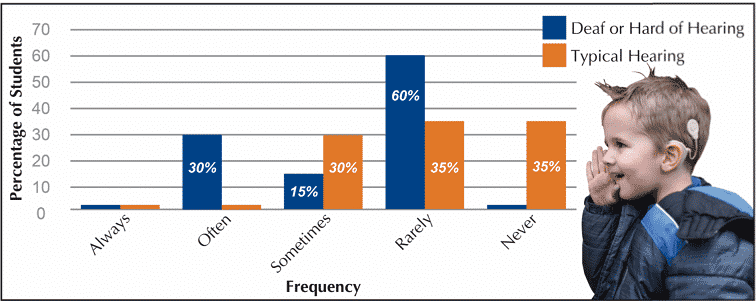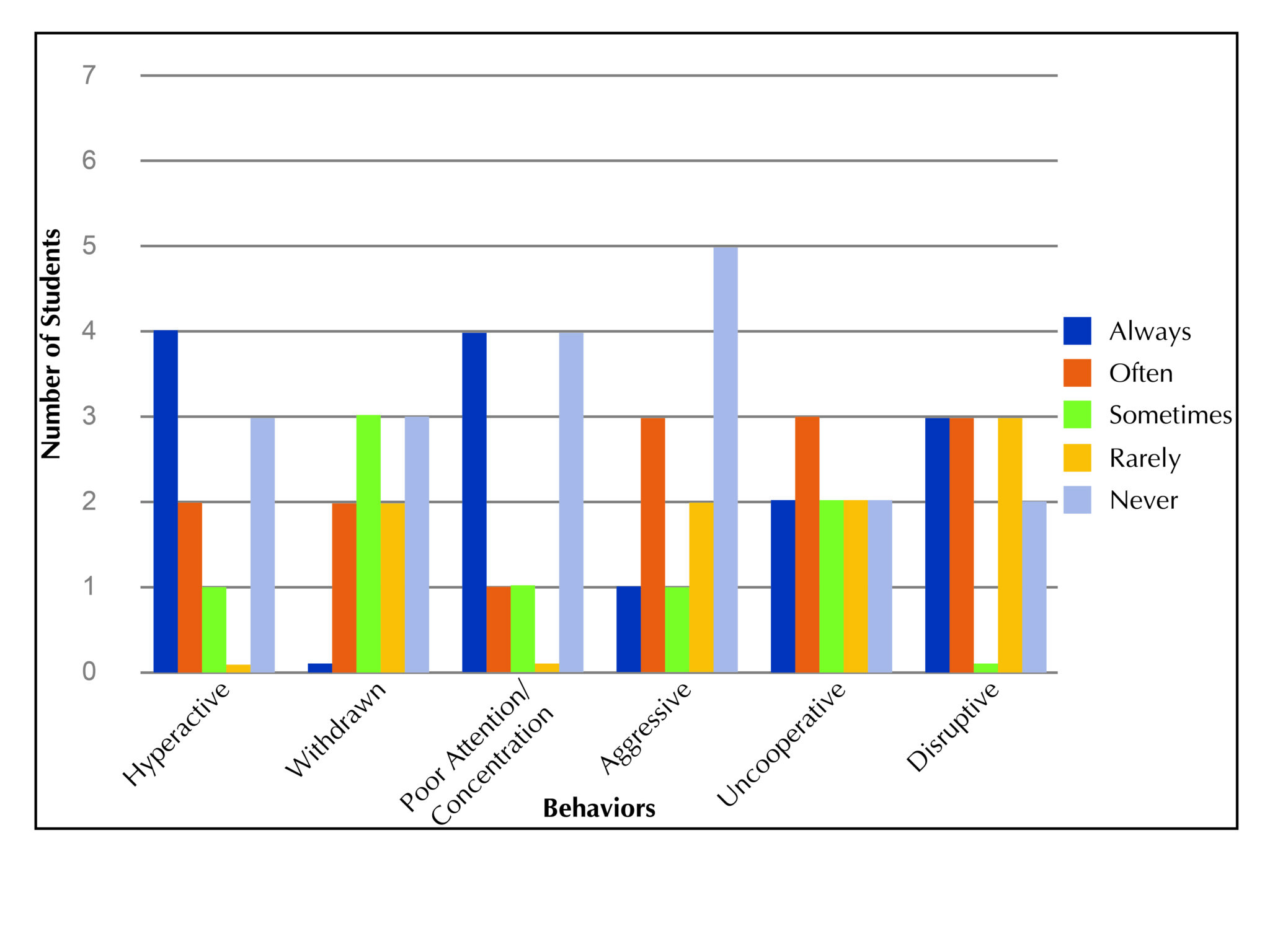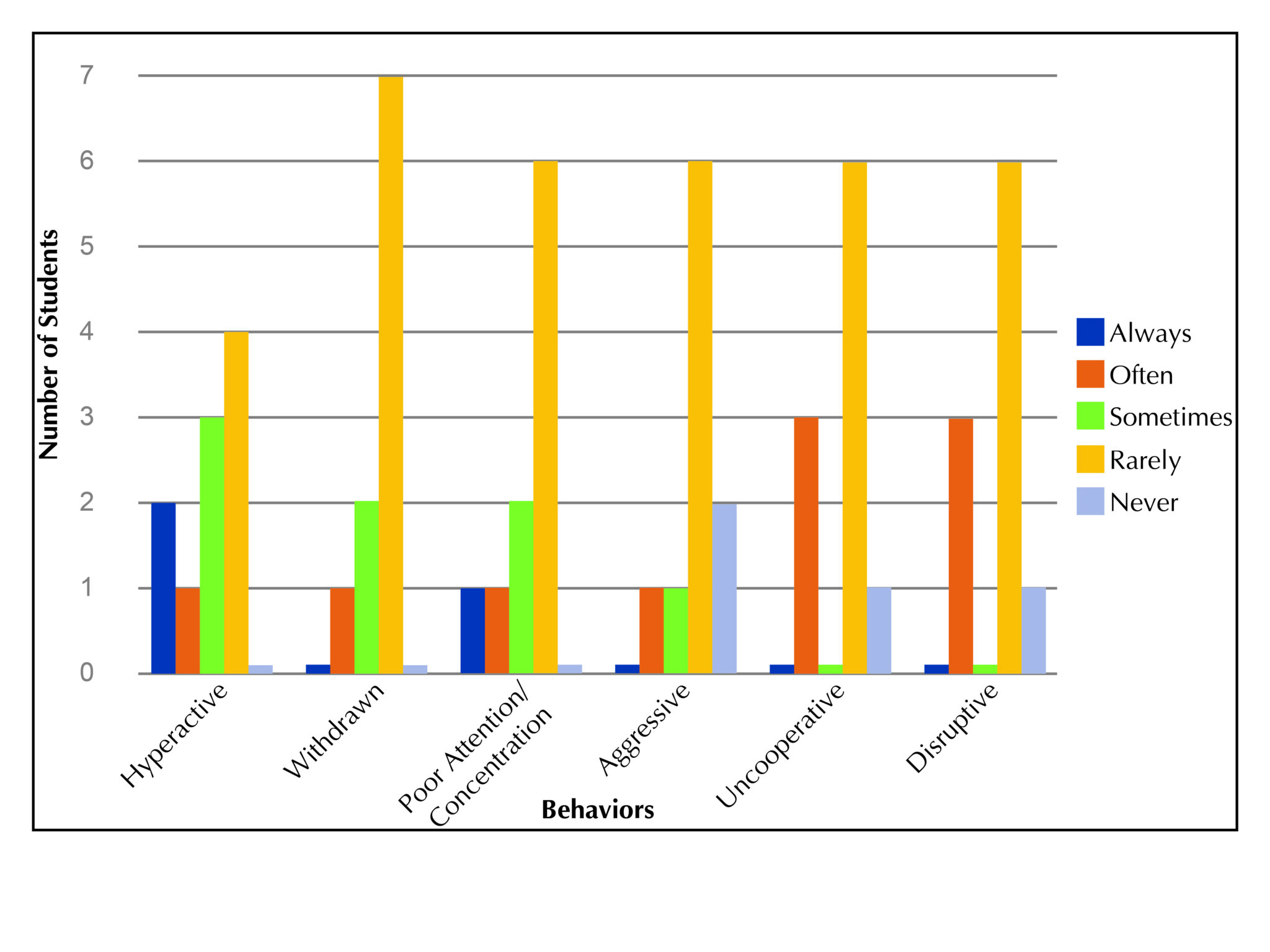Challenging Behaviors: A Comparison Between Students Who Are Deaf or Hard of Hearing and Students With Typical Hearing
by Amanda Mulligan, M.Ed.
OBJECTIVE
To determine if challenging behaviors are exhibited more frequently in children who are deaf or hard of hearing compared to children who have typical hearing, and if communication and language development play a role.
INTRODUCTION
- Language and communication are key components in the probability of behavioral challenges, but are rarely considered in behavioral development models.
- Research has shown that children who are deaf or hard of hearing have more challenges with attention, language, and behavioral development than children who have typical hearing (Barker et.al., 2009).
- Results of former research are inconsistent in analyzing the prevalence of behavioral challenges between students who are deaf or hard of hearing and students who have typical hearing.
- A variety of studies show a high rate of behavioral problems between children who are deaf or hard of hearing and children who have typical hearing, while others show no significant difference.
PARTICIPANTS
Ages 5 to 7 years old
- 10 students who are deaf or hard of hearing
- 10 students who have typical hearing
- Kindergarten and First grade students
FREQUENCY OF COMMUNICATION BREAKDOWN

METHOD
Teachers of the participating students completed a survey pertaining to challenging behaviors they may see displayed by students within their classrooms. Teachers gave their input based on the student’s communication and language skills as well as six categories of behaviors taken from the child behavior checklist. Categories as followed:
- Hyperactive (Constant talking, Constant movement, Cannot remain in seat)
- Withdrawn (Generally unhappy, Stares blankly, Rarely asks for help, Tired)
- Poor Attention/Concentration (Does not follow oral lesson, Daydreams, Rarely completes assignments, Does not attempt work)
- Aggressive (Hitting/Shoving/Kicking, Verbally attacks/provokes others, Argues with teacher, Destructive of belongings/schoolwork)
- Uncooperative (Blames others for mistakes, Does not follow routine, Defiant of teachers requests)
- Disruptive (Demands attention, Does not follow rules, Interrupts lessons)
Teachers rated each student on the six categories of behavior based on a rating scale as follows: Always (constant throughout day), Often (occasionally throughout day), Sometimes (occasionally throughout week), Rarely (occasionally throughout month), and Never.
RESULTS
- There is no significant difference in the frequency of challenging behaviors between children who are deaf or hard of hearing and children who have typical hearing.
- Uncooperative and disruptive behaviors were present in 30% of both groups.
- Five of the ten students with typical hearing also have a diagnosis of an additional disability that has a high probability of impacting their challenging behaviors.
- Students who are deaf or hard of hearing have more frequent communication breakdowns than students with typical hearing.
DISCUSSION
- Findings indicate that there is not a strong relationship between students who are deaf or hard of hearing and challenging behaviors compared to students who have typical hearing.
- Deaf or hard of hearing participants attend a small specialized school for children who are deaf or hard hearing. Class sizes in the specialized school are small, allowing students to have more individualized attention and instruction which may reduce the likelihood of challenging behaviors.
- A larger group of participants is needed to determine if variables such as class size, additional disabilities, hearing equipment, etc., would affect the results.
- Further research is needed to expand on the frequency of challenging behaviors for both students who are deaf or hard of hearing and students who have typical hearing.
BEHAVIORS OF STUDENTS WITH TYPICAL HEARING

BEHAVIORS OF STUDENTS WHO ARE DEAF OR HARD OF HEARING

REFERENCES
Fiorillo, C. E., Rashidi, V., Westgate, P. M., Jacobs, J. A., Bush, M. L., & Studts, C. R. (2017). Assessment of Behavioral Problems in Children With Hearing Loss. Otology & Neurotology : Official Publication of the American Otological Society, American Neurotology Society [and] European Academy of Otology and Neurotology, 38(10), 1456–1462.
Barker, D. H., Quittner, A. L., Fink, N. E., Eisenberg, L. S., Tobey, E. A., Niparko, J. K., & CDaCI Investigative Team (2009). Predicting behavior problems in deaf and hearing children: the influences of language, attention, and parent-child communication. Development and Psychopathology, 21(2), 373–392.
Achenbach, T. M., & Ruffle, T. M. (2000). The Child Behavior Checklist and Related Forms for Assessing Behavioral/Emotional Problems and Competencies. Pediatrics in Review, 21(8), 265–271.

